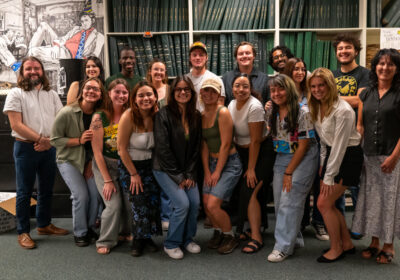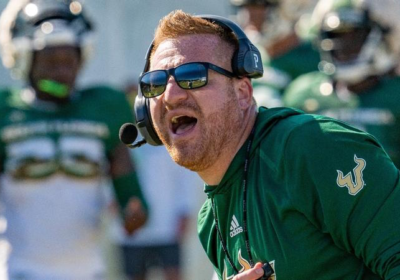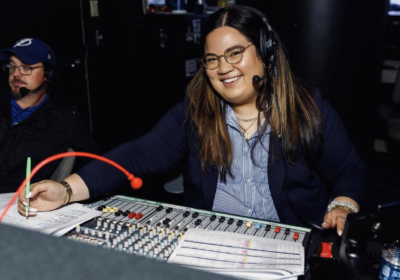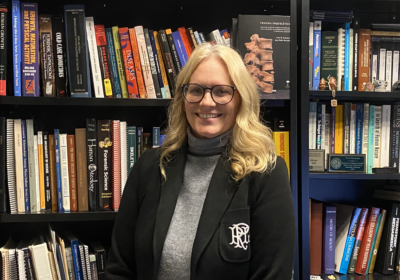Sign Language facilitates learning at USF
When Angie White was a senior in high school, she had a problem rolling her r’s in Spanish class. Her guidance counselor called a conference with her parents, telling them that White was “just not college material.”
“That’s why I went to college-To prove her wrong,” she said.
At Hillsborough Community College, White needed to fulfill a foreign language requirement. She chose not to take a second stab at Spanish. During her first few classes, she fell in love with American Sign Language (ASL).
Today, White is a sign-language interpreter for USF’s Students with Disability Services (SDS). Working morning to afternoon, five days a week, White travels around campus translating lectures for deaf students.
Stationed at the front of the class within clear audible range of the professor, White has to properly translate words into signs, mouth phrases and spell out terms while keeping up with the pace of the lecturer. The task involves more than just translation.
In a psychobiology course, White is rattling off signs for the letters that spell words such as “physiological” and “amphetamine.” For a political science course, White has to plan ways to sign concepts such as “pork-barreling” and “gerrymandering”- terms that will undoubtedly appear on the deaf student’s test.
It is her duty to not only communicate the words, but also their meanings accurately. In any given class, White likely is paying the most attention to the lecture of anyone in the room.
Of the 41 USF students that have reported deafness or hearing loss at the Tampa campus, only eight use ASL interpreters. White is one of seven staff interpreters hired through SDS.
Though not all of USF’s deaf students use them, interpreters serve as the best option for students fluent in ASL said USF’s Coordinator for Deaf and Hard of Hearing Students Peggy Kledzik.
“Depending on the severity of the hearing loss, classroom accommodations can range from the use of a personal FM system to an interpreter or a CART (computer assisted reading technology) provider,” she said. “Interpreters are generally the preferred accommodation for students who have used American Sign Language from an early age.”
White estimates that during a lesson she is anywhere from three to seven seconds behind the professor teaching. As she is signing the teacher’s previous statements, she stores what he or she has just said in the back of her mind. This process, while also accompanying signs with the appropriate body language and facial cues, takes countless hours of practice.
Having worked as an interpreter for 19 years, White’s translating career has not always taken place in the classroom. She’s accompanied deaf clients to doctor’s offices and even on cruises.
Jackie Haig, a senior majoring in communication sciences and disorders, is one of the eight deaf USF students who use interpreters. She said USF interpreters help her all over campus.
“They translate at workshops, events on campus such as Round Up, pep rallies and my dorm meetings,” she said in an email. “Really, anytime when a large group is together.”
Not all interpreters jell with their deaf clients. Haig said she’s had interpreters that she’s loved and others she’s loathed. Her reasons ranged from poor signing skills to over-explaining the lecture.
“They are not there to teach, just to translate,” she said. “Others stop signing when you aren’t looking, some yawned non-stop – inappropriate behavior.”
Off campus, interpreters translate between people on other sides of the country. White also worked for seven years as an interpreter for a Video Relay Service (VRS). Non-deaf callers can contact VRS to connect with a waiting interpreter. The interpreter is then patched through to the deaf recipient’s video phone for a real-time sign language relay of the caller’s words.
Working for VRS, White has eavesdropped on an eclectic array of interesting conversations.
“I’ve done drug deals, booty calls, I’ve called to say granny’s passed away, I’ve ordered pizzas, Chinese food,” she said. “I hate ordering Chinese food.”
VRS interpreting involves a seemingly contradicting mix of both emotional investment and detachment. When a caller is angry, White had to raise her voice to reflect the facial expressions of her deaf caller, and vice versa.
By the same token, once the call ended, White had to level her emotion and prepare for a brand new conversation that might be completely different in tone and subject matter.
“I’ve done really good with the VRS with not getting too emotionally involved,” she said. “But you have to be ready for anything.”
This detachment carries over into the classroom. Haig said she relies heavily on her interpreters to learn, but they maintain a purely professional relationship.
“It’s strictly business,” she said. “We rarely talk about outside of class topics.”
Haig said she prefers interpreters to the technologies offered by disability services.
“As a deaf person who signs, what other better way is there to communicate than to use an interpreter?” she said. “Using CART is too slow. Note takers are too slow. I need on-the-spot access when the teacher is lecturing.”
Though she and her interpreters are not friends, Haig said she knows how valuable they have been.
“I would never be able to know what my teachers were saying without them,” Haig said. “I would still be able to learn, but not as well since I wouldn’t be picking up on everything.”







